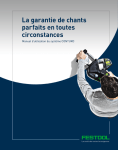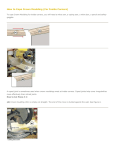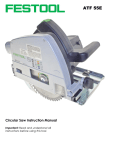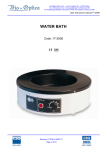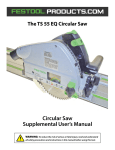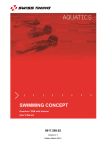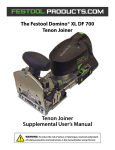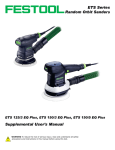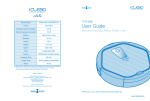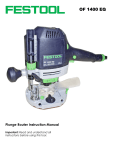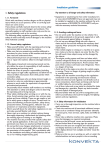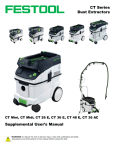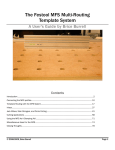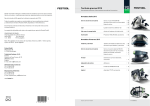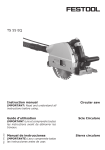Download The perfect edge.
Transcript
The perfect edge. User manual for the CONTURO system. Seen at www.IdealTools.com.au The perfect edge. User manual for the CONTURO system. Seen at www.IdealTools.com.au Introducing Wolfgang Reines. Carpenter. Product manager. Inventor. I always have mixed feelings when visiting This is exactly how “The perfect edge” concept a carpenter‘s workshop. On the one hand, was developed. As a central hand-guided I enjoy the smell of fresh timber and recog- electric power tool for professional edge nise the typical whirring and screeching of banding, the CONTURO was not designed as saws cutting through wood. I also revel in a replacement for stationary edging machines, the atmosphere that I became so familiar but rather as an effective system solution with during my training as a carpenter. But for the manufacture of small batches or then I immediately switch to my role as a rapid production of high-quality edging, product manager, where I have to analyse even on curved, convex or concave shapes. every working situation, every process and One system that represents excellent even every individual action from a very results and is easy to operate, but above all, different perspective. I then arrange a opens up new possibilities for fulfilling the meeting with the cabinetmaker to discover individual wishes of your customers. more about the processes in the workshop. Or hold discussions with staff to gather valuable information on how to achieve the desired result more quickly. Which, for example, could help prevent damage to the material. I also try to obtain ideas that could help achieve an overall better working result. Seen at www.IdealTools.com.au Seen at www.IdealTools.com.au Contents PAGE 1 The perfect edge. The CONTURO in a system. 10 2 Basic information about CONTURO 14 3 Achieving the perfect edge 18 3.1 Preparing the workpiece 20 3.2 Preparing the machine and edge Preparing the machine Display information Selecting and cutting edging to the correct length Adjusting the edge height 22 22 23 24 25 3.3 Mobile gluing of edges Mobile gluing and flush trimming of straight edges Mobile attachment of edging to shaped parts with curves Attaching long strips of edging Mobile attachment of edging to round panels and manufacturing the perfect joint Attachment of edging to internal corners 26 27 29 31 33 38 3.4 Stationary gluing of edges Stationary gluing of straight edges Stationary attachment of edging to mitred workpieces Stationary attachment of edging to small shaped parts 40 42 44 45 3.5 Edge finish Routing and smoothing edges flush, trimming overhanging material Characteristics of routing mitred edges Corner finishing Cleaning edges Sanding and polishing edges High-gloss edging 46 47 48 49 49 50 53 4 Seen at www.IdealTools.com.au PAGE 4 Information on edging 54 5 Information about glue application 58 The CONTURO glue application system The correct temperature The perfect glue supply in line with the material Refilling glue Changing colours 61 61 61 62 63 Tips and tricks 66 Workstation VAC SYS design plan Adaptation of VAC SYS to the MFT Working with dust extraction 68 72 73 Items included, technical data 74 6 7 CONTURO CONTURO accessories Working with the CONTURO as a stationary unit Edge router MFK 700 Basic Edge router accessories Supplementary system accessories – VAC SYS Supplementary system accessories – MFT Seen at www.IdealTools.com.au 76 77 79 80 80 81 82 5 Edging. Part of the design. A beautiful finishing touch. Edges on tables, cabinets and office equipment are just as important as the workpiece itself, because if the finish is not perfect, it affects the overall quality of the workpiece. The glued join may be visible, and dirt can accumulate. In the worst case scenario, it is possible to feel the finsihed edge, and since Festool always strives to achieve perfection down to the smallest detail, we have also dedicated ourselves to ensuring the finish is perfect. We not only wanted to offer an edge gluing system that produces virtually invisible joins, but also to provide an entire system solution for creating the perfect edge by adapting the components perfectly to one another and ensuring that the machine, accessories and consumable materials work hand in hand. Continue reading this manual for more information. 6 Seen at www.IdealTools.com.au Seen at www.IdealTools.com.au 7 8 Seen at www.IdealTools.com.au The CONTURO. Basis for the perfect edge. The CONTURO edge bander allows the simple attachment of edging on anything from rectangular components, to complex free shapes such as curves, radii, convex and concave shapes. These require a maximum inner radius of 50 mm, and a minimum outer radius of 25 – 30 mm (depending on the edging material and thickness). In combination with a bench unit, the CONTURO also gives you the possibility of attaching edging to mitred workpieces to a professionally manufactured quality standard. All classic versions of edging – from wood and plastic to melamine – with a height of 18–65 mm and an edge thickness of 0.5–3.0 mm can be processed quickly and easily in line with the relevant material. Versatile and easy to operate, the CONTURO represents a genuine solution for manufacturing individual shaped parts, as well as affixing edging to workpieces or furniture components produced in small batches. Packed in a SYSTAINER, the CONTURO is also suitable for mobile use as well as manufacturing edging in situ with a perfect quality finish. The following pages show examples of all of these different applications. Seen at www.IdealTools.com.au 9 10 Seen at www.IdealTools.com.au The perfect edge Seen at www.IdealTools.com.au 1 11 Working with MFT Working with the vac sys Preparing the workpiece 1. The perfect edge.The CONTURO in a system. At the heart of the system, the CONTURO is responsible for the gluing process while the surrounding system components perform all other working steps. From cutting and milling chipboard to size or applying glue, pressing down edging, cutting and flush trimming, smoothing and polishing – the Festool system operates with a level of professionalism and clean quality that only bench-mounted machines can achieve. Glues 12 Trimming edging Seen at www.IdealTools.com.au Special accessories 1 System Perfect edge finish CONTURO Gluing edging Stationary tasks Accessories Seen at www.IdealTools.com.au 13 14 Seen at www.IdealTools.com.au Basic information about CONTURO Seen at www.IdealTools.com.au 2 15 2. Basic information about CONTURO Of all the ingenious details that the CONTURO has to offer, one stands out from the rest: unbeatable ergonomics. The horizontal mounted application system guarantees perfect weight distribution, while the pressure on the handles is transferred to the contact roller automatically – for effortless working progress. Force is transferred irrespective of the edging height, as the machine is guided securely along the top of the workpiece. This also makes it easier to adjust the edging height and provides a better view of the glued edge through the support base. 1Handle 5 Start button 9 2 Temperature selection 6 Menu buttons 10 Glue compartment 3 On/off switch 7Display 11 Extractor connector 4 Feed speed 8 12 Mains connection 16 Refill button Seen at www.IdealTools.com.au Edging height setting 2 13 Central plate 17 Glue nozzle 14 Contact roller 18 Support base 15 Infeed roller 19 Handle 16 Drip catcher Seen at www.IdealTools.com.au 17 18 Seen at www.IdealTools.com.au Achieving the perfect edge Seen at www.IdealTools.com.au 3 19 3.1 Preparing the workpiece The respective workpiece must be prepared correctly in order to achieve a perfect edge finish. Several different options are available here: cutting to size on a panel saw with a scoring unit, or using a Festool plunge-cut saw TS 55 R together with guide rail and splinterguard, or even cutting the edge with a Festool router and guide rail. Whichever system you choose, the workpiece should be 100 % clean and splinter-free in preparation for subsequent attachment of the edging. Plunge-cut saw TS 55 R/ TS 75 Router OF 1400/OF 2200 20 Seen at www.IdealTools.com.au 3 Seen at www.IdealTools.com.au 21 3.2 Preparing the machine and edge A few settings must be configured before the CONTURO can be operated. The display on the machine automatically guides you through the necessary steps. Preparing the machine 1 2 Secure the support base first using the accompanying screw. Insert a minimum of two adhesive cartridges before using for the first time. Changing colours Page 63 Changing colours, refilling, etc. Chapter 5 3 4 You can use the temperature preselection switch to adjust the temperature according to the colour of the adhesive cartridge selected. Now press and hold the ON button until the Festool logo appears on the display. Correct temperature Setting 1 = 190 °C for natural coloured adhesive Setting 2 = 200 °C for white adhesive 22 Seen at www.IdealTools.com.au 3 5 The machine heats up until the setpoint temperature is reached. The heat-through phase then starts, which is indicated on the display. When the display changes from red to green, the machine is ready for operation. Tip You can also adjust the temperature individually: press the mode button until the temperature indicator flashes, set the desired temperature using the arrow buttons and press OK to confirm. The CONTURO takes approximately eight minutes to fully heat up. The thermally isolated gluing unit ensures that the surface temperature of the machine remains low, thereby eliminating any risk of burns. Glue quantity Page 61 For adapting the glue quantity Chapter 5 Switching units The display can be switched from Celsius to Fahrenheit and metres to feet. Display information REMAINING EDGE LENGTH Temperature in °C or °F Temperature setting Glue quantity Arrow buttons Feed speed Mode The display indicates how many metres of edging can be processed at the preset edging height and glue quantity. The actual temperature is also displayed. Seen at www.IdealTools.com.au 23 Selecting and cutting edging to the correct length 1 2 Select the edging height according to the thickness of the prepared panel material and include an overhang of approx. 4 mm. 3 Edging over 1.5 m in length Page 31 If the edging is longer than 1.5 m, it is more convenient to work with the edging holder. 4 Simply score the edge band (plastic side) with a knife to ensure a clean separating cut. 24 You should add approx. 10 cm to the length of the edging. It is then easy to break off. Seen at www.IdealTools.com.au Adjusting the edging height 3 1 2 Slide the edge band into the edging infeed. NOTE Note that the edging height can only be adjusted at operating temperature. 3 Briefly press the start button. Use the rotary knob to adjust the edging height until the edge band touches at the top and bottom. Then turn back the switch 1–2 locking positions so that there is some play in the edge band. 4 When the symbol for inserting the edging appears, guide the edging into the active infeed until it is drawn in. When the tick mark appears on the display, the edging has reached starting position and the machine is ready for gluing. Seen at www.IdealTools.com.au 25 3.3 Mobile gluing of edges The CONTURO is now ready to start fixing the edging to the workpiece. The most important thing is that the workpiece is clamped securely. You can work on the Festool multifunction table MFT/3 either with screw or lever clamps, or use the Festool VAC SYS vacuum clamping system or a combination of both. The VAC SYS system was used in our example because the workpiece is accessible from all sides – ideal for fixing edging to round workpieces. VAC SYS Refer to the chapter “Tips and tricks” for further information on working with the VAC SYS and MFT/3 as well as a plan of a workstation. Page 66 MFT 26 Seen at www.IdealTools.com.au Mobile gluing of straight edges 3 1 2 Position the CONTURO with the edging inserted and the support base resting on the workpiece. Maintain a distance of approx. 2 cm between the workpiece and contact roller. The machine must be aligned at a 90° angle to the panel edge. The marking line is located at the leading edge of the panel. 3 Press the start button again. The edging is automatically coated with glue and fed along the workpiece. The machine now operates automatically without the user having to hold the start button pressed down. 4 As soon as the edging becomes visible to the right of the mark, start the gluing process by guiding the machine along the edge of the workpiece. The machine then feeds the edging automatically, all you have to do is guide the machine while applying constant pressure. You have the option of selecting one of two speed settings. You can change the speed at any time, even during the gluing process. Simply press the button for the feed speed momentarily to increase or decrease the speed of the machine. This function is extremely useful for attaching edging to tight curves. Seen at www.IdealTools.com.au 27 Mobile gluing (continued) and flush trimming of straight edges 5 6 Remove the machine from the end of the workpiece in the edging direction. NOTE Liquid glue on the end of the edging, for example, can be extremely hot. 7 8 The tabletop on either side of the trimming machine allows you to trim left and right panel edges ergonomically to the same standard. Tip Allow the end of the edging to cool before trimming and make sure the trimming blades are sharp to guarantee a clean and accurate cut. You should replace blunt or damaged trimming blades with new blades, which are available as spare parts. 28 The overhanging edging is now trimmed with the Festool trimming machine KP 65/2: insert the edge band between the trimming blades, move the trimming machine up to the stop pin, position parallel to the workpiece and press the handles together. The result: edging trimmed flush with extreme precision. The KP 65/2 trimming machine is also suitable for trimming edging with a height of 18 – 65 mm and a thickness of 0.5 – 2.0 mm. Positioning the trimming handles in the trimming direction makes it much easier to trim thicker edging. Round panels Page 33 The KP 65/2 trimming machine can be converted to trim joins with a few hand movements. Seen at www.IdealTools.com.au Mobile attachment of edging to shaped parts with curves The CONTURO can attach edging to curves with an inner radius of 50 mm and a minimum outer radius of 25 – 30 mm. The thicker and more brittle the edging material is, the larger the radius must be. The process for attaching edging to curves is essentially the same as attaching edging to straight workpieces. However, there are some small differences that you should bear in mind. 3 1 The additional roller is a helpful accessory for narrow curves and awkward spots. It increases the bending radius of the edging and offers an additional pressure point during attachment for better adhesion. To attach the additional roller, slide it into the groove provided until it engages. 2 3 The additional roller helps during the attachment of edging to tight outer curves by pressing down on the curved workpiece together with the other roller. It is always advisable to process narrow internal curves with the additional roller. Tight curves When affixing edging to tight internal or external curves, set the feed speed to the 1st setting before starting work or during the task by pressing the feed speed button. Seen at www.IdealTools.com.au 29 Mobile attachment of edging to shaped parts with curves (continued) 4 Like the process for attaching straight edging, trim the overhanging end of the edging flush using the trimming machine. It is also advisable to work with the additional roller when attaching rigid or brittle edging. The edging has a larger bending radius and does not break as easily. Tip Instead of gluing one thick piece of edging along narrow external curves with wooden edges, simply glue several thin layers of veneer on top of one another. 30 Seen at www.IdealTools.com.au Attaching long strips of edging With edge bands longer than 150 cm, there is a risk that the edging will drag on the floor and become soiled or stuck. The edging holder (accessory) was designed to avoid this situation. The edging is rolled up neatly in the holder to guarantee an even feed into the machine. As a result, you can process up to 8 m of edging * both quickly and easily. 3 * Depending on the relevant edge band material (measurements: height 18 – 45 mm, thickness 0.5 – 2.0 mm). 1 2 Mount the edging holder first of all. Simply attach to the pins provided and secure with the locking mechanism. 3 You must cut the edging to length first and roll it up with the visible side facing inwards because you cannot work directly from the roll in the edging holder. 4 Place the roll of edging in the holder, positioning the end of the edging in the direction of the edging infeed on the machine. Start drawing the edging into the machine by pressing the start button once. Thread the edging through the gap in the edging holder and into the infeed. Gluing can begin as soon as the machine draws in the edging. Seen at www.IdealTools.com.au 31 Attaching long strips of edging (continued) 5 Now apply the edging to the workpiece in the usual way. 6 The edging is fed accurately to the workpiece from the edging holder. 32 Note Edging with larger dimensions can be also fed into the machine from the edging holder. Seen at www.IdealTools.com.au Mobile attachment of edging to round panels The greatest challenge when affixing edging to round panels is creating a clean join at the point where one end of the edging meets the other. The Festool trimming machine is also extremely practical in this regard. 3 When attaching edging to circular panels, it is important that the workpiece can be accessed from all sides without having to change the clamping position. We recommend using the VAC SYS vacuum clamping system, which can secure the workpieces quickly and safely, rotate them 360° and tilt them up to 90°. 1 Pads of different shapes and sizes are available for a wide range of workpieces and can be changed without using tools. They are manufactured from high-quality plastic which is so soft and flexible that even high-gloss polished surfaces remain free of scratches and damage. 2 When cutting the edge band to size, make sure that you add approx. 10 cm to the overall band length. Trim the leading end of the edging exactly perpendicular because it forms part of the join. Glue the edge in the usual way. The edging holder is a practical accessory that offers maximum freedom of movement and protection of the edging. Seen at www.IdealTools.com.au 33 34 Seen at www.IdealTools.com.au Mobile attachment of edging to round panels (continued) and manufacturing the perfect joint 3 3 4 Make sure that the overhanging end of the edge band does not come into contact with the other end that has already been glued. 5 Tip If the edging material is particularly delicate, protect the front end with adhesive tape to prevent any contact with glue. 6 Note If you wish to hold the edging, remember that the glue is still hot. Set the trimming machine to the “Join” configuration. Adjusting settings for butt joints Setting the trimming machine see operating manual Seen at www.IdealTools.com.au 35 Manufacturing the perfect join (continued) 7 8 Mark the cutting point on the edge band. Guide the overhanging end of the edge band over the stop pin between the trimming blades. Push the trimming machine forwards towards the workpiece up to the stop pin until the edge band that has already been glued, rests against the inner stop. 9 10 Position the trimming machine so that the marking on the edge band is located in between the trimming blades. Then use the fine adjustment feature to adjust the blades more accurately: the scale indicates whether you have to cut more or less from the edge band. Once the mark is located exactly between the two trimming blades, trim the piece of edging. After trimming, use a hot air blower to heat the edge band with glue already applied. Note Plastic edging stretches when heated and may have to be trimmed slightly more. The best approach is to test the actual edging material. TIP Before trimming, push the trimming blades together to achieve better alignment. 36 Seen at www.IdealTools.com.au 3 11 12 Complete the join by pressing down the edge band with a block of wood. TIP If you intend to manufacture several identical workpieces, you can continue working with the value preset on the trimming machine without making any markings. 13 The result: the perfect join. Seen at www.IdealTools.com.au 37 Attachment of edging to inner corners Inner corners of 90° are usually found on corner cabinets and shelves, which incorporate compartment or carcass bases. Edging these panels is challenging because the inner corners must be glued. 1 2 Ensure you clean and trim the leading end of the edging perfectly perpendicular, as it forms part of the join. 3 4 As soon as the end of the edging is positioned precisely in the inner corner, guide the machine out of the corner with an even pressure. At the same time, press down the end of the edging in the inner corner with the thumb on your right hand to achieve maximum adhesion. 38 Place the CONTURO on the workpiece in the usual way and position the machine on the inner corner. Press the start button to feed the edging automatically. Note Always work with the additional roller! Always work with the slowest feed speed when affixing edging to inner corners (speed 1). TIP If the edging is longer, it may make sense to engage the help of another person to generate the required contact pressure on the inner corner. Seen at www.IdealTools.com.au 3 5 Turn the panel so the inner corner is located on the right hand side of the machine. The machine can then be guided from left to the right, along the side that has no edging. Seen at www.IdealTools.com.au 39 3.4 Stationary gluing of edges You can also work with the CONTURO as a stationary unit. Simply insert an adapter plate in the MFT/3 multifunction table or a bench you have built yourself. Not only can you affix edging to straight edges or curves, but also oblique edges with an angle between 90° – 45° because the CONTURO can be tilted 90°– 45° in the stationary unit. 1 If you intend to use the CONTURO in the MFT/3, first replace the perforated board with panel LP-KA 65 MFT/3. The recess in the panel is the right size for installing the adapter plate and the threaded bushes for the guide plates. If you are working with a bench you have built yourself, the tabletop will require a recess and a cut-out so that the adapter plate can be screwed in flush. Refer to the accompanying routing template for the exact dimensions. 40 Seen at www.IdealTools.com.au 3 2 3 Then mount the adapter plate and guide plates as described in the operating manual. The guide plates make it easier to guide the workpiece over the bench. 15 guide plates are delivered with the adapter plate as standard but additional guide plates are available as accessories. Insert the CONTURO in the adapter plate as follows: first tilt the adapter plate upwards and lock in position. TIP The hole spacing on the guide plates is designed for system 32, which makes it easier to manufacture individual worktops. You can also screw on guide plates without threaded bushes using normal wood screws. 4 5 Then release the lock on the right and left of the panel, slide the CONTURO into position and lock again. Now set the required angle on the scale and lock both clamping screws. Your stationary unit is now ready. Seen at www.IdealTools.com.au 41 Stationary gluing of straight edges To glue onto straight edges, place the CONTURO in a horizontal position and guide the workpiece past it. This working method is very practical for small or narrow workpieces that are difficult to clamp. 1 2 Set edging height with some play so that the edging slides smoothly through the machine. 3 4 Ensure the correct speed is selected before you begin the gluing process, as both of your hands will be placed on the workpiece. 42 Then press the start button and guide the machine towards the edge. Position the workpiece at a distance of 2 cm from the contact roller and press the start button again. Seen at www.IdealTools.com.au 3 5 As soon as the glued edging becomes visible, press the workpiece against the contact roller. TIP When processing rigid or brittle edging in the stationary unit, it is also advisable to work with the additional roller (included with the adapter plate). Screw on the additional roller and guide the workpiece along it at a slight angle. The edging has a larger bending radius and does not break as easily. The additional roller can be used for applications such as tight inner and outer curves or mobile applications – both rollers press down the edging and the extended pressure zone achieves better adhesion. 6 Guide the workpiece along the contact roller while applying even pressure. Seen at www.IdealTools.com.au 43 Stationary attachment of edging to mitred workpieces Simply tilt the CONTURO in the stationary unit to affix edging to a mitred edge. The scale indicates the angle in degrees. 1 2 Loosen both clamping screws on the angle scale, set the desired angle and tighten the clamping screws again. 3 TIP Edging for mitred edges requires a slightly larger overhang. For example, edging 35 mm high is used on a 19 mm panel with a 45° edge. 4 Use the guide rail adapter to ensure the workpiece is guided parallel and prevent the edging from running off course. Adjust the guide rail adapter to the thickness of the edging you are using. Available thickness settings are 0.5, 1, 2 and 3 mm. 44 Adjust the edging height in the usual way. Select the desired speed before starting the gluing process as you will always need both hands on the workpiece when gluing. Seen at www.IdealTools.com.au 3 5 6 Place the workpiece on the guide rail adapter and guide evenly past the CONTURO. Loop the edging over the black guide pin so that it does not obstruct the working area. Your mitred edge is quick and easy to glue. Stationary attachment of edging to small shaped parts In order to attach edging to shaped parts, you may have to partially unscrew the guide plates otherwise they could prevent you from turning and guiding the workpiece along the CONTURO, depending on the shape. The edging is glued as already described. TIP If you have to unscrew all the guide plates, simply attach them to the underside of the shaped part using double-sided adhesive tape. This ensures the part is at the correct height in relation to the edge bander or edge band, and also that the correct amount of edging is overhanging. Seen at www.IdealTools.com.au 45 3.5 Edge finish Once the edging is glued and trimmed, add the finishing touches: cut away overhanging material, smooth edging, finish corners and polish edging to a high gloss finish if necessary. Ideal for routing edging: the Festool MFK 700 Basic edge router with spring-loaded ball bearing guide brake and chip deflector. This is designed specially for machining the most delicate of edging without leaving behind marks. The scraper is made from durable solid carbide and was specially designed for smoothing edges. The scraper has three integral edges (R1, R1.5 and R2 mm) for smoothing routed curves and rounding thin edging. MFK 700 edge router Scraper 46 Resting the scraper on the attached cord ensures perfect guidance. The three different edges on the scraper allow you not only to smooth down edging, but also round thin edging. Seen at www.IdealTools.com.au Routing and smoothing edges flush, trimming overhanging material 3 1 2 First trim the overhang from the edging using the MFK 700 so that it is flush with the panel. Practical: the extractor hose is attached directly at the tabletop and does not pose an obstacle when guiding the machine. The ball bearing guide brake ensures perfect, streak-free working results. 3 4 To achieve a clean, rounded finish, move the edge router towards the edging with the cutter rotating and trim the overhang as well as the radius. 5 If the cutter leaves impact marks during the routing process, you can smooth them over using the scraper. You can remove any remaining overhang using the scraper. Note Special classic ogee cutters with reversible blades are available for the MFK 700 Basic with radii of 1, 1.5, 2 and 3 mm. Suitable for edging thicknesses of 1, 1.5, 2 and 3 mm. Seen at www.IdealTools.com.au 47 Characteristics of routing mitred edges Please note that a radius cannot be created due to the angle and only flush milling of mitred edges is possible. The S8 HW OFK plane cutter for the MFK 700 Basic was specially developed for milling 0° – 45° edges. 1 2 First install the router cutter in the MFK 700 Basic. Then mill the workpiece flush. 3 Make sure that the extraction hood under the machine is resting directly against the workpiece as this can be used as a guide. Then create the radius on the wooden edge using sandpaper. S8 HW OFK plane cutter for routing 90° – 45° edges. TIP Use one of the edges on the scraper to smooth the radius on plastic edging. Use the straight edge on the scraper to smooth and round off the flat inner angle. Draw the scraper over the edge several times until the radius or curve is perfect. 48 Seen at www.IdealTools.com.au Corner finish Cleaning the corners is particularly important. If the edge is routed and not reworked, a slight overhang usually remains, which must be removed. We recommend you use Festool Brilliant 2 sandpaper, with P320 grit to remove any significant unevenness. 3 Using a sanding cloth after this will help produce a semi-matt finish which is smooth and even. Cleaning edges Once the radius on the edge is perfect, the edge should be cleaned. Use a plastic cleaner – edging manufacturers will recommend a compatible cleaner. Seen at www.IdealTools.com.au 49 Sanding and polishing edges If the result achieved with the scraper is not sufficient, you can always sand and polish the edge. Festool also offers suitable system accessories here – for a finish adapted perfectly to the edging. 1 First attach the correct abrasive with a P320 grit to the hand sanding block. 2 3 You can eliminate cutter impact marks left behind after milling by simply sanding the edge. Repeatedly move the hand sanding block lightly over the edge in a steady motion to achieve this. Note Do not sand the surface of plastic-coated panels! 50 The appearance of plastic edging changes when processed and often turns white. Attach a sanding cloth to the hand sanding block and rework the edge to match the colour with the decor again. The cloth produces a semi-matt finish on plastic edging and the surface of the edge blends in with most decorative finishes. Seen at www.IdealTools.com.au 3 4 5 Right of image: stress whitening from sanding plastic edging. Left of image: edging without stress whitening, reworked with cloth. 6 High-gloss surfaces can also be polished. Attach the polishing felt to the hand sanding block. 7 Dab a small amount of MPA 6000 polish onto the polishing felt and rub over the surface. Polish the edge … 8 … and remove any polish residues. TIP Stress whitening is generated when edging is trimmed. You can remove the whitening simply by rubbing an offcut of edging over the affected area while applying slight pressure. Seen at www.IdealTools.com.au 51 Sanding and polishing edges (continued) 9 The result: the perfect edge. 52 Seen at www.IdealTools.com.au High-gloss edging When working with the CONTURO, dust or foreign matter on the surface of the panel may leave scratches on particularly delicate surfaces. We reccomend you use the scratch protector with felt pad available as an accessory from Festool, to prevent any damage. 3 1 2 Change the base runner on the underside of the support base by removing the four screws. Then secure the guide plate on the LAS-STF-KA 65 scratch protector, which has a Velcro fastener underneath. 3 The surface is protected … Secure a felt pad to the protector to guarantee ease of movement over the workpiece. Note The scratch protector includes 3 felt pads, replacement felt pads are available separately in packs of 10. 4 … and remains free of scratches. Seen at www.IdealTools.com.au 53 54 Seen at www.IdealTools.com.au Information on edging Seen at www.IdealTools.com.au 4 55 4. Information on edging The CONTURO is capable of processing a wide range of different edging materials. We recommend using the additional roller when processing thick or brittle edging. The roller helps process rigid, thick veneered edging more easily. More information on the additional roller Page 29 The CONTURO can affix edging with a height of 18 – 65 mm and a thickness of 0.5 – 3.0 mm. Use of the edging holder restricts the maximum edging height to 45 mm and the maximum edging thickness to 2.0 mm. The values for particularly brittle or thick edging, or edging with extreme interior / exterior curves, may deviate from the values mentioned above. Carrying out tests is the best way to ensure the correct value. Edging thickness 0.5–3 mm 56 Edging height 18–65 mm Seen at www.IdealTools.com.au 4 Seen at www.IdealTools.com.au 57 58 Seen at www.IdealTools.com.au Information on glue application Seen at www.IdealTools.com.au 5 59 5. Information on glue application The Festool unique glue application system on the CONTURO, offers a host of benefits. For example, the heating grid only melts the exact amount of glue required. This prevents heating glue unnecessarily and retains the adhesive properties and colour of the glue to ensure consistently good results. One other advantage of this technology is that heat requirements and energy consumption are low during operation. The system for supplying glue from the glue cartridges is also extremely simple, clean and convenient. Easy, clean and efficient working progress and unique cartridge gluing system for quick colour changes. Glue applied to edging 60 Seen at www.IdealTools.com.au The glue application system on the CONTURO The glue is applied to the edge band through a nozzle for greater precision, guaranteed clean edges and narrow joins. The glue dosage is adapted automatically to the preset edging height. The “remaining edge length” indicator on the display shows how many metres of edging can be affixed with the current settings. Additionally, you always know whether you need to insert additional glue cartridges, which is important because it is not possible to insert cartridges during the gluing process. 5 The correct temperature The CONTURO has two temperature settings: Setting 1 = 190 °C for natural coloured glue Setting 2 = 200 °C for white glue The perfect glue supply in line with the material When applying glue to porous materials such as chipboard, it is advisable to increase the flow of glue. Simply press the mode button in the display menu until the value you wish to change flashes. Use the arrow buttons to change the value and press OK to confirm. The remaining edge length is recalculated automatically in line with the new preset glue quantity. Seen at www.IdealTools.com.au 61 Refilling glue If the petrol pump symbol appears on the display or there is not enough glue to affix the edging, refill the machine as follows before starting the next gluing process: 1 2 Press the refill button and wait until the glue feed has moved back. The display now indicates that the machine is in refill mode. Wait until the hourglass symbol has disappeared before opening the flap. 3 4 Place the new glue cartridges (of the same colour) into the magazine. 62 Lift the flap as soon as the open symbol appears. Close the flap again and wait until the glue feed moves forward and exerts pressure on the cartridges. The refill process is now complete and you can continue working with the CONTURO. Seen at www.IdealTools.com.au Changing colours Festool offers glue cartridges in the colours white and natural. The white glue is mainly suitable for producing virtually invisible joins on bright and white materials, whereas the natural coloured glue is ideal for all types of wood and other colours. If you wish to change the colour of the glue, the glue with the old colour can be pressed from the machine without an edge band, as described here. 5 1 2 The CONTURO system contains approximately the same quantity of glue as three glue cartridges. You must therefore use three cartridges to purge the machine completely. 3 Now press the refill button, … Place the machine on the edge of the bench for purging and remove the drop catcher. Position a container (e.g. box) under the CONTURO to catch the hot glue. 4 … wait until the feed has moved back and open the flap. If you can see full cartridges with the old colour in the machine, these can now be removed. Seen at www.IdealTools.com.au 63 Changing colours, continued. 5 6 Insert new adhesive cartridges in the desired colour and close the flap again. 7 8 Actuate the safety lever for purging the machine while simultaneously turning the rotary knob clockwise until the central plate rests against the bottom of the machine. The machine now is set to purging position. Note Glue may escape immediately. 9 64 Adjust the rotary knob to the maximum edging height. Press and hold the start button until the purging symbol appears on the display. Glue now starts to escape from the nozzle. Allow purging to continue until the new colour escapes from the nozzle. You may have to repeat steps 3 – 8 to insert additional cartridges. You can finish or interrupt purging by pressing the start button again and turning the rotary knob clockwise until the desired edging height is set. The glue nozzles are then closed again, the display indicates that the machine is ready for normal operation. Insert the drop catcher again at the end of the purging process. Seen at www.IdealTools.com.au Notes 5 Seen at www.IdealTools.com.au 65 66 Seen at www.IdealTools.com.au Tips and tricks Seen at www.IdealTools.com.au 6 67 6. Tips and tricks Some components of the Festool system make working with the CONTURO even easier because all components have been adapted perfectly to one another. Below are a few examples of how to make your daily work easier. Plan for VAC SYS workstation When working with the CONTURO, the workpiece must be secured firmly before any edging can be affixed. And round workpieces that cannot be clamped from edge to edge must be accessible from all sides. Many tasks described in this manual were therefore performed with a Festool VAC SYS vacuum clamping system adapted perfectly to the correct working height of the CONTURO. You can find the plan for this workstation and other tips here. 1 68 2 Seen at www.IdealTools.com.au 6 3 Seen at www.IdealTools.com.au 69 Plan for VAC SYS workstation Front view 500 500 500 Total height You can individually adjust the overall height to your body height and the desired working height. 540 540 640 640 540 640 This plan gives a working height of 90 cm (including the VAC SYS). 400 1250 400 400 1250 1250 Base panel The workstation is secured to a square base panel, 1,250 x 1,250 mm. 70 Seen at www.IdealTools.com.au Left side view Right side view with recess for compressed air hose, control elements and plug-it cable 380 380 380 380 380 380 320 320 320 320 320 320 215 215 215 6 365 365 6060 97 97 7070 97 60 365 140 355 355 355 70 140 140 5050 50 with recess for pump ventilation Seen at www.IdealTools.com.au 71 Attaching the VAC SYS to the MFT The multifunction table MFT/3 provides another option for working with the VAC SYS. Since the working height of a VAC SYS mounted on the MFT is too high for most users working with the CONTURO, we recommend the following adaptation: Ø 0,6 Ø 0,6 60 12 500 Ø 0,6 325 87,5 87,5 Ø 0,6 Ø 0,6 For example, use a birch multiplex panel with a thickness of 23 mm (500 mm x 250 mm). Drill holes with a diameter of 6 mm according to the drawing. The VAC SYS is secured with 4 x M5 60 mm carriage bolts and 4 x M5 wing screws with washers. 72 250 193 Ø 0,6 The board is secured to the MFT via the groove on the side profile of the MFT. Compatible keys and rotary knobs are available from Festool as spare parts: 2 x 437377 key, 2 x 482110 rotary knob Seen at www.IdealTools.com.au Working with dust extraction 6 When working with the CONTURO, you can extract any vapours with a Festool mobile dust extractor – which makes tasks that take longer more pleasant. There is an extractor connector located behind the machine, which can be attached to a Festool suction hose D 27. All Festool mobile dust extractors are suitable for dust extraction. Vapours are discharged away from working area, but remain within the room. The CT 17 mobile dust extractor also offers the possibility of connecting a second suction hose to discharge the exhaust air outside. Seen at www.IdealTools.com.au 73 74 Seen at www.IdealTools.com.au Items included, technical data Seen at www.IdealTools.com.au 7 75 7. Items included, technical data CONTURO KA 65 Items included Technical data Edge bander KA 65 Plus Edge bander KA 65 Edge bander, complete with guide table, 4x natural EVA adhesive, in a SYSTAINER SYS 4 T-LOC Power 1,200 W Mains frequency 50/60 Hz Edging height 18 – 65 mm* Edge thickness 0.5 – 3.0 mm* Edge bander KA 65 Set Inner radius > 50 mm* Edge bander, complete with guide table, 4x natural EVA adhesive, in a SYSTAINER SYS 4 T-LOC and edge trimming set SYS KB-KA 65, in a SYSTAINER SYS 4 T-LOC Heating time approx. 8 min Edge trimming set SYS KB-KA 65 Edging holder, additional roller, trimming machine, scraper, base runner scratch protector with 3x felt pad, 5x polishing felt, 20x abrasive sheets StickFix Brilliant 2 80x133 mm P320, hand sanding block 80x133 mm, 5x StickFix sanding cloth S 800, polish MPA 6000 Melting temperature Default setting Setting 1 190 °C Setting 2 200 °C Melting temperature Setting range Setting 1/2 Feed speed 1st gear 2 m/min 2nd gear 4 m/min Safety class Weight (without glue cartridges and mains cable) * Depending on material 76 Seen at www.IdealTools.com.au 100 – 210 °C 1 7.9 kg CONTURO KA 65 Accessories Polishing felt PF-STF 80x133 STF H/5 5x polishing felt StickFix, 80 x 133 mm XX For polishing high-gloss edging in combination with polish MPA 6000 and hand sanding block HSK x 80 x 133 EVA adhesive, EVA nat 48x-KA 65 48x natural EVA adhesive, diameter 63 mm, height 26 mm, processing temperature 190 °C XX Affixing wooden, plastic or laminated plastic edging to panel materials XX EVA universal adhesive with high melting point, also suitable for use on objects with a higher resistance to temperatures XX Natural colour tone suitable for all types of decor 7 EVA adhesive, EVA white 48x-KA65 48x white EVA adhesive, diameter 63 mm, height 26 mm, processing temperature 200 °C The adhesive is delivered in boxes of 48. XX Affixing wooden, plastic or laminated plastic edging to panel materials XX EVA universal adhesive with high melting point, also suitable for use on objects with a higher resistance to temperatures XX Perfect join quality on white decor Scraper ZK HW 45/45 Dimensions 4.5 x 4.5 x 1.2 cm, with 1 mm, 1.5 mm and 2 mm radius XX Trimming overhanging material after the edge is cut (plastic edging) without damaging the surface of the workpiece XX Smoothing away impact marks left by cutters during the routing process (R1, R1.5 and R2 mm curves) XX Breaking edges, affixing curve and cleaning thin plastic edges and inclined edges/mitred edges (R1, R1.5 and R2 mm curves) XX Scraper rested on the attached cord for perfect guidance XX Solid carbide for greater durability and resistance to wear Additional roller ZR-KA 65 For use on thick or inflexible edges, offers a second pressure point XX Safe processing of thick and brittle veneered edges due to large bending radius of the edge XX For affixing edging to tight curves and shaped parts XX Offers additional pressure point for applying more pressure on the edge of the board when glued Seen at www.IdealTools.com.au 77 CONTURO KA 65 Accessories Base runner scratch protector LAS-STF-KA 65 Base runner with fastener, 4 retaining screws, 3x felt pads. XX For using the edge bander on delicate or high-gloss surfaces XX With StickFix system for quick and easy replacement of the felt layer Replacement felt EF-LAS-STF-KA 65 10x 10x replacement felt, for use with base runner scratch protector LAS-STF-KA 65 Edging holder KSP-KA 65 For feeding in long or delicate edging. For a maximum edging height of 45 mm, maximum edging thickness 2 mm. XX For the safe guidance of delicate and thin edging into the edge bander KA 65 XX Safe guidance of long edges without damaging or soiling XX Max. edge lengths of 8 m (edge thickness of 2mm) possible XX Easy machine guidance, even along long edges Trimming machine KP 65/2 Trimming height 65 mm, trimming thickness 2 mm. For trimming on the right and left side as well as circular edging. 78 XX Join trimming function (for round table) and trimming of panel edges (final trimming) with a single machine XX For trimming plastic edging with a height of 18 – 65 mm and a thickness of 0.5 – 2.0 mm (depending on material) XX Ergonomic handle location for easy, effortless trimming, even on thick edging XX Patented eccentric fine adjustment for precision join trimming XX Tabletop on both sides of the trimming machine allows the user to trim left and right panel edges from above - with a perfect view of the workpiece Seen at www.IdealTools.com.au CONTURO KA 65 Accessories for bench-mounted applications Perforated board KA 65 LP-KA 65 MFT/3 Perforated board for stationary use of the CONTURO in the MFT. For use in combination with adapter plate AP-KA 65. Includes M4 reducing rings for attaching guide plates. XX With cut-outs for stationary use of the edge bander in the MFT multifunction table in combination with the adapter plate AP-KA 65 Adapter plate AP-KA 65 Adapter plate for using the CONTURO as a stationary machine. Mounting plate complete with 15 guide plates. Length 254 mm, width 420 mm, swivel range: 0 – 47° XX For mounting the edge bander on a workbench XX For small batches, straight edges, free form elements and gluing inclined edges, angle from 0 – 47° XX Adapter plate for installation in the MFT (with perforated board KA 65) or a separate workbench XX Sliding guides for guiding the workpiece safely XX Allows the user to swivel the machine (0 - 47°) in the bench and position the workpiece horizontally during edging - for convenient and safe guidance, even with larger objects 7 Guide plate MFT GP-KA 65 MFT/3 15 guide plates, for guiding workpieces in stationary applications. Length 255 mm, width 31 mm, height 6 mm XX Replacement or extension guide plates for the stationary use of the edge bander with adapter plate AP-KA 65 in MFT (with perforated board KA 65) or installed in a separate workbench XX Guide plates for attachment using chipboard screws or M4 screws included with the delivery Seen at www.IdealTools.com.au 79 Edge router MFK 700 Basic Module edge router MFK 700 EQ/B-Plus 230-240V Module edge router for machining overhanging edges, ball bearing guide brake, in a SYSTAINER SYS 2 T-LOC XX Edge router specially designed for flush trimming and rounding protruding edges XX Unique ball bearing guide brake ensures perfect, streak-free working results XX Possible to flush trim 0 – 45° inclined edges (depending on cutter) XX Good view of the workpiece, extraction directly from the table XX Perfect working results with precision fine adjustment XX Large support base ensures safe guidance Technical data Power consumption Idling speed 720 W 10,000–26,000 rpm Collet dia. Fine routing depth adjustment Cutter diameter Dust extraction connector Weight 6 – 8 mm 14 mm max. 32 mm 27 mm 1.9 kg MFK 700 Basic Accessories Plane cutter S8 HW OFK Cutter for routing edges 90 – 45° Diameter 28 mm, working length 7 mm, angle 15°, total length 40 mm Classic ogee cutter with reversible blades XX Cutter for rounding wood and plastic edges as well as solid wooden workpieces XX Reversible carbide blade provides extreme precision, no resharpening required XX Extremely economical due to long useful life XX Reversible blades can be used 4 times and are easy to replace Plane cutter Classic ogee cutter with reversible blades S8 HW R1 D28 KL12.7OFK Diameter 28 mm, working length 1 mm, radius 1 mm, total length 55 mm Classic ogee cutter with reversible blades S8 HW R1.5 D28 KL12.7OFK Diameter 28 mm, working length 1.5 mm, radius 1.5 mm, total length 55 mm Classic ogee cutter with reversible blades S8 HW R2 D28 KL12.7OFK Diameter 28 mm, working length 2 mm, radius 2 mm, total length 55 mm Classic ogee cutter with reversible blades S8 HW R3 D28 KL12.7OFK Diameter 28 mm, working length 3 mm, radius 3 mm, total length 55 mm Classic ogee cutter with reversible blades 80 Compatible replacement reversible blades are available for all classic ogee cutters. Visit www.festool.com for more information Seen at www.IdealTools.com.au Vacuum pump and clamping unit VAC SYS VAC SYS Set SE 1 Vacuum pump VAC SYS VP in SYSTAINER SYS 3, vacuum clamping unit VAC SYS SE 1 with vacuum pad VAC SYS VT D 215 mm, vacuum hose and foot valve in SYSTAINER SYS 4 VAC SYS SE 2 Vacuum pad VAC SYS VT 275 x 100 mm, connecting piece, vacuum hose, in a SYSTAINER SYS 4 Technical data Power consumption at 50 Hz 160 – 200 W Power consumption at 60 Hz 200 – 230 W Pump capacity at 50 Hz 2.7 m 3/h Pump capacity at 60 Hz 3.5 m 3/h Minimum vacuum Weight ≥ 81% /≥ 810 mbar 7 8 kg VAC SYS Accessories Vacuum pad VAC SYS VT 200x60 for VAC SYS SE 1, VAC SYS SE 2, pad dimensions 200 x 60 mm, in a carton Vacuum pad VAC SYS VT 275x100 for VAC SYS SE 1, VAC SYS SE 2, pad dimensions 275 x 100 mm, in a carton Vacuum pad VAC SYS VT 277x32 for VAC SYS SE 1, VAC SYS SE 2, pad dimensions 277 x 32 mm, in a carton Vacuum pad VAC SYS VT D 215 for VAC SYS SE 1, VAC SYS SE 2, diameter 215 mm, in a carton Adapter VAC SYS AD MFT 3 for VAC SYS SE 1, VAC SYS SE 2, for connecting the VAC SYS clamping unit with the MFT 3, in a carton Accessories SYSTAINER VAC SYS VT Sort VAC SYS VT 200x60, VAC SYS VT 277x32, VAC SYS VT 275x100, also offers space for VAC SYS VT D 215, in a SYSTAINER SYS 3 Seen at www.IdealTools.com.au 81 Multifunction table MFT 3 Multifunction table MFT 3 Table with perforated board and foldaway legs, swivel unit, support unit, angle stop, stop flag, guide rail FS 1080/2, deflector FS-AW, additional clamp, in a carton XX Maximum precision – with aluminium profile for retaining a guide rail and the angle stop XX Firm hold – specially developed clamping elements secure workpieces with maximum flexibility XX Avoid straining your back – the working height of 90 cm is comfortable even for taller users XX Ideal for mobile applications – the MFT 3 folds down easily Technical data Table dimensions 1,157 x 773 mm Table height, legs folded away 180 mm Table height, legs unfolded 900 mm Maximum workpiece thickness Max. workpiece width Load capacity Weight 78 mm 700 mm 120 kg 28 kg MFT 3 Accessories Cross brace MFT 3-QT for additional stabilisation of the MFT 3, 2 in pack, diameter 20 mm, length 675 mm, in a carton Fixed clamps MFT-SP for safe and precise clamping of the workpiece (for sawing, sanding, routing, drilling, etc.), 2 in pack, in self-service display pack Fastening clamp FSZ 120 Polished steel version, clamping width 120 mm, pack of 2, in self-service display pack Clamp FSZ 300 Polished steel version, clamping width 300 mm, pack of 2, in self-service display pack Lever clamp FS-HZ 160 polished steel version, clamping width 160 mm, in self-service display pack Connecting piece VS for attaching the FST 660/85 or MFT 800 to Basis Plus, for connecting several MFT 3 units, in self-service display pack Adapter VAC SYS AD MFT 3 for VAC SYS SE 1, VAC SYS SE 2, for connecting the VAC SYS clamping unit with the MFT 3, in a carton 82 Seen at www.IdealTools.com.au Notes Seen at www.IdealTools.com.au 83 Seen at www.IdealTools.com.au Festool Group GmbH & Co. KG Wertstrasse 20 D-73240 Wendlingen TTS Tooltechnic Systems GB Ltd Saxham Business Park Saxham Bury St Edmunds Suffolk IP28 6RX Great Britain Phone: +44 (0) 1284 760 791 Fax: +44 (0) 1284 702 156 E-mail: [email protected] Festool Group GmbH & Co. KG Export Department Wertstrasse 20 D-73240 Wendlingen Phone +49 (0)70 24/804-20640 Fax +49 (0)70 24/804-20724 E-mail [email protected] Tooltechnic Systems (AUST) Pty Ltd Postal address: PO Box 4401 Dandenong South VIC 3164 Australia Service Hotline: 1800 063 900 Phone: 03 9799 9733 Fax: 03 8795 9221 E-mail: [email protected] www.festool.com Subject to alterations and errors. Products may differ from those pictured. Created for Festool Group GmbH & Co. KG, 73240 Wendlingen, 1/2014 Seen at www.IdealTools.com.au























































































